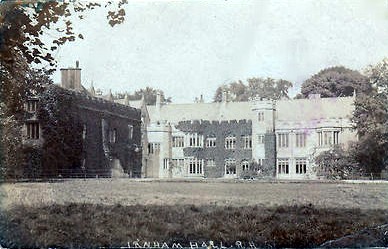|
Village cricket by REX NEEDLE
The great game is over for another season. The sound of leather on willow has faded from the Abbey Lawn where Bourne Cricket Club tests the resources of the visitors to the enjoyment of players and visitors alike although anticipation is already high for the coming year when the weekly fixtures can begin again. This annual enjoyment for all began when cricket became a national sport towards the end of the 18th century and our own club probably originated soon afterwards, the earliest mention being in 1803 from a poster advertising a return cricket match between Bourne and Sleaford in the summer of that year followed by lunch at the Bull Hotel [now the Burghley Arms] at five shillings a head. Over the next few years regular matches were held with local clubs and we have a flavour of the game from 1833 with a delightful account of an end of season encounter with Irnham village, six miles north west of Bourne, which was played in the grounds of Irnham Hall at the invitation of Hugh Charles Clifford, the 7th Baron Clifford, who had recently gone to live there and on Wednesday 2nd October, he played host to the two teams. “The inhabitants of this happy little village were in their element”, reported the Stamford Mercury the following Friday. “Irnham has long been celebrated for its eminent cricket club and this was his treat as a finale for the season”. The report continued: “Several of their friends were invited from Bourne and the neighbourhood of Irnham in order to raise a sufficient number to form a full game and early in the morning, eleven were speedily arranged on each side for competition. Some very good batting was exhibited: one party obtained 115 runs in one innings and against the fine bowling of Mr Phipp” The scene at Irnham that day must have been quite delightful because the newspaper report likened it to the writings of Mary Russell Mitford (1787-1855) which was praise indeed because at that time her work was extremely popular, notably her sketches of village life with vividly drawn scenes and characters based on Three Mile Cross, a hamlet in the parish of Shinfield, near Reading in Berkshire, where she lived, and included an evocation of village cricket on such an afternoon. There was even an absence of betting which was extremely popular at cricket matches in those days, a practice that often overshadowed the sport itself. “But”, said the newspaper, “there was none of that petty artifice and low cunning that betting and blackguardism which too frequently, alas, are the accompaniments of this manly and truly English pastime, was visible. No. Here was exhibited all honour and honesty, good play coupled with unanimity of feeling. “During the game, the players, and the whole of the spectators were regaled with an excellent cold collation served up from the hall, the worthy occupant of which, and his lady, were present during nearly the whole of the game and manifested the greatest anxiety for the comfort and enjoyment of all present. The day will not soon be forgotten in this peaceful and domesticated little village.” Unfortunately, the cricket club at Irnham no longer exists, having folded as so many other village teams have done over the past forty years. Bourne Cricket Club, however, continues to thrive with four adult teams and a strong junior following, the first team playing in the Lincolnshire Premier League, but all players give delight to the town with their regular games at the Abbey Lawn which is widely regarded as one of the finest cricket grounds in Lincolnshire. WRITTEN NOVEMBER 2014
Go to: Main Index Villages Index |
